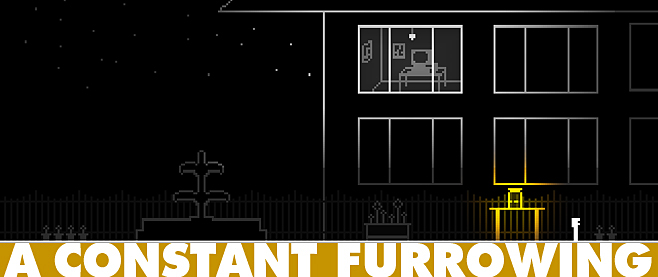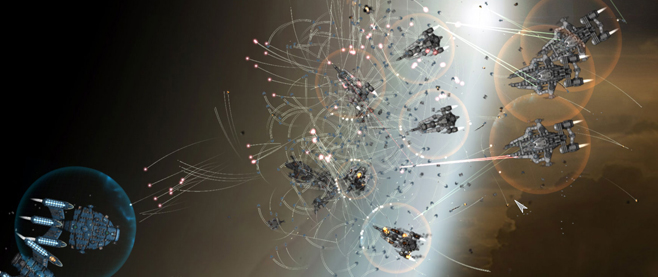
A Conversation with Game Developer Jake Elliott
Jenn Frank interviewed game developer Jake Elliott in time for last year’s Indie Games Festival, but once she had the entire interview in front of her, she hardly knew what to make of it.
Elliott has remained busy, though: in the year since their interview, he has released Balloon Diaspora and Ruins.
Elliott’s latest work, The Penguin’s Dilemma, is a reworking of an old NES puzzle game called Binary Land. Now it is a narrative about communication and love, requiring two players.
The Penguin’s Dilemma will be a playable installation at Super Button Mashers, a gallery exhibit opening February 11 at Chicago’s OhNo!Doom.
You can read the long version of the interview here.
———
Jenn: So you were actually nominated in [last] year’s IGF Nuovo category for A House in California. And this is an adventure game with really simple images, and simple, kind of graphical parser commands?
Jake: Yeah.
Jenn: I made my best childhood friend play – I didn’t make her play it – but my best childhood friend played A House in California. And halfway through, I asked her to stop playing it. So that we could go do something else.
Jake: [Chuckles] That’s cool.
Jenn: No, but she wouldn’t! And she played it to its end. It isn’t a long game, but she played it to its end. And she does not play games. So it seemed like it was this really good crash course – for her – in adventure game logic.
 Jake: That’s great.
Jake: That’s great.
Jenn: And I know that it was also part of the – was that kind of the – I mean, is that on purpose? [Laughs] Like I know that the game was part of the “Learn to Play” exhibit in, was it Cupertino?
Jake: I mean, I wasn’t thinking of it as a tutorial…. Yeah, it’s funny, the name of that thing, and I never really understood exactly why they called the exhibit that, or what the title meant, exactly, but –
Jenn: Well, I can tell you why! Because I watched my friend play your game, and it was like, oh, this is really perfect, as an exhibit. And it’s the kind of thing that maybe other people would hover around, going, “Go! Do that! Click on the cloud!”
Jake: I guess I can…. It does resonate for me, the idea of it being a tutorial or someone’s first encounter with that genre. It was real important to me that you couldn’t make any mistakes in that game. So every action you do has a response. Like, some text hidden behind it?
Jenn: I enjoyed that, actually! I think I got through the game … not missing anything.
Jake: Oh, wow.
Jenn: Which is maybe the completist, or completionist, in me.
Jake: [Laughs] Yeah, that’s a lot of text. I’m glad, though, because I wrote all that text – it took me a really long time. So it’s nice to know somebody read it all.
Jenn: And my best friend did, too! Simply, you know, to see what would happen.
Jake: Yeah. Yeah. So that’s great, because also, the main kind of criticism that I heard from people that I showed it to, or people who wrote about it online, was that it has that kind of – what they would always talk about as this “adventure game logic,” or something where you’re trying to guess what the designer might be thinking, and [the logic] doesn’t really follow players.
And I thought about that, very early on when I was making the game, that this might be something that would happen, with these very weird [parser] verbs and these weird sentences that I wanted to have as part of the game. So I wanted there to be kind of like an advent calendar discovery thing, where there’s something underneath everything you flip over. So that it felt more you’re discovering what the words are, rather than discovering the logic.
Jenn: I actually take a lot of issue with that criticism! I almost personally feel defensive, because the thing I really enjoyed in watching my friend play was, she did know what to do next in any given moment. And for her it was just, how to accomplish it? And so it was like she was learning this dream-logic language.
And she knew that she needed to do something to get off this one screen, for instance. And so she automatically puts it together: Oh, why don’t I just look at the sky. And I asked her, while she was playing, How did you know to do that? And she said, I don’t know.
Jake: [Laughing] Yeah, it, right, subconscious. Intuitive, some kind of…?
 Jenn: Right, exactly! But it is very much about trying to understand the dream-logic that the game’s author is directing you toward. And I wanted to talk to her about that, but our conversation was really clipped. Because we didn’t know how to talk about that.
Jenn: Right, exactly! But it is very much about trying to understand the dream-logic that the game’s author is directing you toward. And I wanted to talk to her about that, but our conversation was really clipped. Because we didn’t know how to talk about that.
Jake: Oh, yeah, right. Because she’s not a gamer.
Jenn: She’s not a gamer! Well, and it’s not something I’ve ever asked, you know, someone who’s fresh to gaming about. How do you know? I don’t know. So there is something really interesting about the player’s decision-making, I guess.
Jake: And it’s kind of a weird case, this one too, because it doesn’t hold your hand, necessarily, there’s no instructions, really. But then, also, there’s not like a whole lot of freedom, exactly, and you can’t move through the game in a different pattern than the one I’ve built. You can play around in each space, but you can’t – there’s not a whole lot of agency, as far as progress through the game, so it’s kind of in a weird spot that’s not quite Farmville, and not quite Grand Theft Auto, you know? [Laughs]
Jenn: You just reminded me of something else. I did notice, when I was playing through some of your other stuff, you don’t really offer much in the way of instructions with any of your games.
Jake: Yeah, but people can figure it out. It’s surprising to me, how much instructions…. Like especially these Flash games! People are playing these games in Flash portals; they just played, like, twenty other games before they got to your game. Like, they’re pretty – you know what I mean? The instructions take way too much time.
Jenn: But with House in California though, there was no instruction, there were no tutorials. But it’s true, too, with all the games you’ve made so far, they’re really intuitive? And you don’t waste too much time [with instructions], except to mention that you can pause the game by pressing ‘P.’
Jake: Right. I mean, I never, like I said, I didn’t think of it as teaching people how to play games, but um, there are a few different ways that kind of resonates. Another one is the kind of retro part of it? The kind of throwback. Like I remember in, I read that blog post you did that I really enjoyed, about the game when you played it, where you mentioned that it was – you’ve played Mystery House probably more than I have, and you mentioned that it like –
Jenn: I’ve started Mystery House.
Jake: I played it a tiny little bit, and then I watched a “Let’s Play” YouTube video. I remember you mentioned that it didn’t really seem like…. In all my texts about the game, I make a lot of this resemblance between House in California and Mystery House?
Jenn: Which, it does not [resemble]. Yeah.
Jake: No, I know. [Laughs] So what happened was, I was drawing the – I had figured out I could do white-on-black, really simple crude drawings, pixel-drawings for this game, and then I stumbled across Mystery House, never having played it. And I was like, Oh, that looks so much like what I’m doing. So I started trying to, like, make that connection as much as possible? Just because I thought it was kind of interesting, you know, [because] it’s the first graphical adventure game. That seems like a really nice point to start from.
Jenn: Sure! All people are learning to play there.
 Jake: Yeah, exactly! Everybody who’s playing Mystery House for the first time, then, when it was released, was totally, yeah, being taught to play by the game. And that game is super unforgiving! That game is extremely difficult to figure out!
Jake: Yeah, exactly! Everybody who’s playing Mystery House for the first time, then, when it was released, was totally, yeah, being taught to play by the game. And that game is super unforgiving! That game is extremely difficult to figure out!
Jenn: That’s where it started. That’s where the entire adventure game genre first went down the wrong path.
Jake: And you know, I’ve read some, I don’t know, it’s an interview or something with Roberta Williams, where she’s like, No! It’s supposed to be hard; this is for an elite category of computer users who can figure out these puzzles. Isn’t that a crazy attitude? To have? That really blew my mind when I read that.
Jenn: But people also went insane playing Mystery House, and started calling the Williams family kitchen, and then they were stunned that the hint line was just their house. And so that was like the first hint line. So in a way, by being unbelievably demanding and unforgiving, they also invented the “walkthrough.”
I did not take issue with A House in California‘s almost nostalgic aesthetic. Where it’s harkening maybe to this, what is it? Kind of a tribe past? A consensual past? That none of us really actually had? Because no one our age actually did play Mystery House? But a lot of us do know what it is. And so it’s this kind of “retro” that is nostalgic for a time that none of us was part of.
Jake: Oh, yeah, yeah. And it’s nostalgic in – I always like to think of a lot of these pixel-art things as being “nostalgic” and not “retro,” because they’re really not about reproducing anything in the way that it actually looked. They’re totally about constructing together some kind of aesthetic that is more about wish-fulfillment than memory? Or something?
Jenn: Yeah. I think that’s what I wanted to get at.
Jake: Yeah, totally. Like, there’s that short pixel art documentary on YouTube – did you ever watch that?
Jenn: Should I?
Jake: I don’t know, it’s cool! The guy who made it interviews Jason Rohrer for a really short time, but Rohrer mentions that pixel art – the way that we look at pixel art now – it totally doesn’t resemble the way that it looked on the NES or SNES. Because those were plugged into televisions? And so they were kind of like smeared together? So they didn’t have a blocky look?
Jenn: Yeah, Ian Bogost talks about that a lot, too, about how for a long time you couldn’t or shouldn’t emulate Atari 2600 games on the computer, because you don’t have the phosphor burn, which the original artists really did intend. Like, Berzerk looks really cool because the robots are strobing. It’s crazy, and the walls are glowing! And when you emulate it, it’s just like, Hey, there’s a [not-glowing] blue wall.
Jake: That stuff’s super interesting to me, in the way that pixel-art and chiptunes and stuff are so part of the conversation. Like in indie games it’s interesting for me to think about that in depth, like think about that as nostalgia, and not just as retro, and work with that….
Jenn: Right, but it’s nostalgic for something that didn’t actually even exist.
Jake: Yeah, but that’s part of nostalgia.
Jenn: So I Can Hold My Breath Forever is an underwater platformer. And I think it’s one of your better-known games?
Jake: I think so, yeah.
Jenn: And the player has ten seconds to find his way to any breathing spot. A lot of people complain about underwater levels in, like, Mario games.
Jake: Because they get panic.
Jenn: [Laughs] Yeah! Well, we never stop and consider how Mario is able to go such distances, uh, without getting air. Yeah, no! That’s what I wrote down [in my notes], is when I got too far from the surface in your game, I started feeling “panicked desperation,” is what I wrote. I’m supposed to, then?
Jake: Well, I don’t know. I wasn’t trying to create a sense of panicked desperation, but I think that’s, um, yeah, that happens to me, too, playing that game, or playing other underwater levels. It’s sort of terrifying.
You know, it’s kind of funny. I talked to this developer, an iPhone developer who wanted to port that game to the iPhone. I think he’s Belgian, or…? I can’t remember exactly. I talked to him on the phone, and he was like, a lot of iPhone games are really not doing so well, because it’s hard to identify with a spaceship or a monster, or something like that – it’s not part of our lives? But everybody, everybody is afraid of drowning. So I think your game would do very well.
 Jenn: Wow.
Jenn: Wow.
Jake: Kind of an insane position he was taking, but – [Laughs]
Jenn: That’s like a really great compliment!
Jake: Right. [Laughs] Yeah.
Jenn: No, and people did respond really well to the game’s, right, the quiet, mounting panic that you feel when you worry that you’re about to drown. Even though the game doesn’t really punish you. At all! It’s not like real-life drowning; you just start back at the last waypost.
Jake: Yeah.
Jenn: So that was interesting to me, was exactly how panicked I was at the prospect of drowning – or being on a timer, I guess, which is a very human fear. Being on a timer, we’re all dying, ahhh, timers. But no, yeah, I was so panicked, even though, if time ran out, absolutely nothing awful was going to happen to me. It wasn’t, like, game over.
Jake: Right.
Jenn: Like I would just continue from where I left off.
Jake: Yeah, the timer was real important. So the game actually takes place over a really ambiguous time scale, [playing from here to there], and the timer ended up playing against the time scale of the game in a strange way, where the players are really conscious of the fact that there’s only ten seconds passing between each save space, but the letters that they’re reading are saying, are talking –
Jenn: – across years!
Jake: Across years, right.
Jenn: In my [real] life, a year or more will go by, and then I’ll get a crazy, insane email from a missing friend about how so much time has gone by, and now we’re on really separate paths. And so I think I put together that those were the kinds of missives I was getting across space and time, in this game.
Jake: Yeah. I mean, I guess, thinking about the different kind of time scales that a friendship can happen on, and so trying to make the player inhabit both or all those time scales kind of at once while they’re playing the game, or at least think about all those scales. And yeah, think about the real estrangement that can happen.
That’s a really weird experience, like you’re talking about getting a letter from somebody, and they’re on this other path. And it seems like it’s been a long time, but it also seems like it hasn’t really been that long, but things have diverged so much, it’s like, really striking. That estrangement is a really strange feeling.





